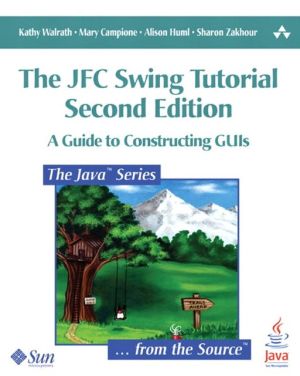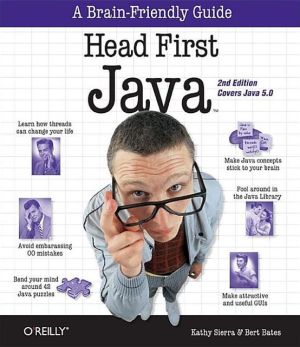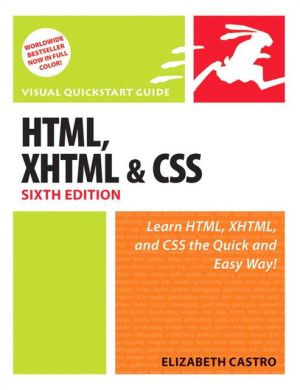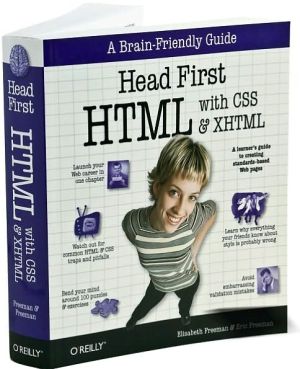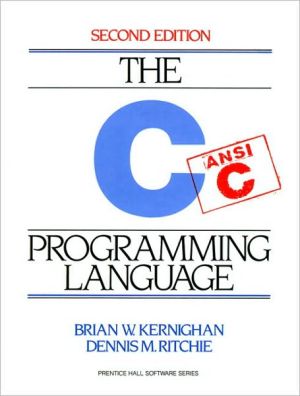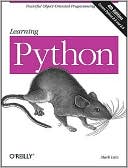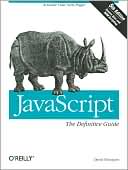The JFC Swing Tutorial: A Guide to Constructing GUIs
The JFC Swing Tutorial is back, fully revised and updated to include the latest revisions to the JFC Swing API and the Java 2 platform. In this book, authors and Java experts Kathy Walrath, Mary Campione, Alison Huml, and Sharon Zakhour—working closely with the Sun Microsystems Swing team—explore the ins and outs of creating GUIs with Swing components.\ This task-oriented, example-driven tutorial allows you to create user interfaces that work without change on multiple platforms, appearing...
Search in google:
The JFC Swing Tutorial is back, fully revised and updated to include the latest revisions to the JFC Swing API and the Java™ 2 platform. In this book, authors and Java experts Kathy Walrath, Mary Campione, Alison Huml, and Sharon Zakhour—working closely with the Sun Microsystems Swing team—explore the ins and outs of creating GUIs with Swing components.This task-oriented, example-driven tutorial allows you to create user interfaces that work without change on multiple platforms, appearing and performing as well as or better than native interfaces. Leveraging the full power of the latest edition of the Java 2 platform, the authors bring the art of GUI creation to life with content new to this edition. This includes an easy-to-use tabbed reference section, new introductory chapters, and coverage of newer features such as JSpinner, JFormattedTextField, JProgressBar, mouse wheel support, the rearchitected focus subsystem, and improved support for drag and drop.Coverage includes: Introductory material for developers getting started with Swing, including sections on basic components such as text fields, labels, and buttons, as well as on using images The latest advice from the Swing team about thread safety Advanced Swing material, including changing key bindings, manipulating the focus, using data models, and adding painting code that uses the powerful Java 2D™ API How-to discussions on using individual components and containers, including advanced components such as tables, trees, and text editors Over 150 complete, working code examplesFor the novice or experienced Java developer looking to create robust, powerful, and visually stunning GUIs, The JFC Swing Tutorial, Second Edition, is an indispensable tutorial and reference.
PREFACE: \ This volume of The Java(TM) Tutorial tells you how to write GUIs that use the Java(TM) Foundation Classes (JFC) "Swing" components. You can use the information in this book both with the Java 2 platform (Standard Edition, v 1.2 and compatible versions) and with JDK(TM) 1.1 (with additional JFC 1.1 libraries).\ The online form of The Java(TM) Tutorial has covered the Swing components since their first public early access release—Swing 0.2, which came out in July, 1997. Through the many early access releases, the Tutorial kept pace with API changes and additions. Readers and reviewers kept us on our toes, helping us improve each page tremendously. However, readers often requested a printed version of the online material. This book is that version.\ About This Book's Structure\ The hyperlinked origins of this book may be evident as you read it. For instance, underlined phrases throughout this book mimic online links. A link to material within this book is followed by the appropriate page number. A link to material outside this book, such as to the JDK API documentation, is accompanied by a footnote that contains a URL. Other evidence of this book's online origin can be found on the first page of each lesson and major section, which provides the URL where the lesson or section can be found in the online Tutorial.\ You might be wondering why we use the terms "trails" and "lessons." We know that people don't learn linearly. People learn by posing a problem, solving it, uncovering other problems, solving them, and learning information as the need arises. Our original vision for the online Tutorial was toencourage and enable this type of thinking and learning. We envisioned a mountain of ski trails, where at any junction, a reader could choose the most interesting or appropriate path at that time. But we also needed some sort of structure and organization, so we created a two-tiered hierarchy: trails at the top level and lessons within them. This book consists of the largest Tutorial trail, Creating a GUI with JFC/Swing.\ Acknowledgments\ We would like to thank every member of the Swing project. They're a great team of people who do excellent work and are fun to be around. For help with general technical issues, we depended on two people. Hans Muller, the Swing project lead, provided not only reviews of individual sections, but also gave sound advice and help with overall issues. Amy Fowler reviewed individual sections and, as someone with broad knowledge of both the AWT and Swing, helped us to correctly describe such architectural features as graphics support.\ Reviewers of individual how-to sections include Philip Milne, who gave masterful reviews of the table and list portions and supplied the sorter example. Georges Saab reviewed the menu- and action-related discussions. Scott Violet provided invaluable help with the text and tree pages. Jeff Dinkins reviewed several sections and also provided quality-of-life enhancements such as tile samples and miniature phone lists.\ Earl Johnson and Peter Korn, from the accessibility team, gently prodded us into covering accessibility well. Their demos, coaching, and careful review of the accessibility section helped us improve it greatly.\ It's always a pleasure working with Pat Chan, whose early review of this book helped us determine its scope and approach.\ Other reviewers and Swing team members that we'd like to thank include Mike Albers, Tim Prinzing, Tom Santos, Steve Wilson, Rich Schiavi, Tom Ball, Jim Graham, and Hania Gajewska. Rick Levenson, the original manager of the Swing project, was very supportive. We look forward to working with the new manager, Howard Rosen.\ Alison Huml performed production duties on this book, juggling coursework, paid work, RSI, and a household move. Without her, this book wouldn't exist. She also drew most of the pictures in this book, with the exception of the cartoony ones, which were drawn by Kathy's sweetheart Nathan.\ Jennifer Ball helped us at crucial points, doing such tasks as checking API tables and code snippets, and converting graphics examples.\ Lisa Friendly, our manager and series editor, gave us the freedom and support necessary to do our work—and enjoy it. Stans Kleijnen and Jon Kannegaard, respectively the director of product engineering and the vice president of the Java platform, also contributed to an atmosphere that let everyone do their best.\ We'd also like to thank the team at Addison-Wesley: Mike Hendrickson, Sarah Weaver, Evelyn Pyle, Jacquelyn Young, Marina Lang, and Julie DeBaggis. They've been a pleasure to work with.\ Finally, thank you to our readers.\ \
PrefaceBefore You Start1Ch. 1Getting Started with Swing3Ch. 2Learning Swing by Example11Ch. 3Using Swing Components35Ch. 4Laying Out Components within a Container87Ch. 5Writing Event Listeners107Ch. 6Performing Custom Painting129Ch. 7Components Reference147Ch. 8Layout Manager Reference457Ch. 9Other Swing Features Reference509Ch. 10Event Listeners Reference643AppTroubleshooting Reference733Index745The JFC Swing Tutorial CD Contents767
\ BooknewsA book/CD-ROM package using a task-oriented, example-driven approach to introduce fundamental concepts and applications for using the new Swing components provided by the Java Foundation Classes (JFC). An appendix lists source code for example applications and applets. The CD-ROM includes Swing and Java software, and a hypertext version of three Java tutorial books. Can be used as a tutorial or a reference. Assumes some experience writing programs using the Java platform. The authors are senior technical writers at Sun Microsystems, Inc. Annotation c. Book News, Inc., Portland, OR (booknews.com)\ \
